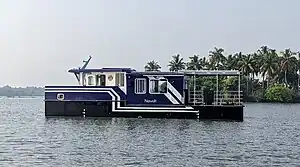 | |
| History | |
|---|---|
| Name | Barracuda |
| Owner | Mazagon Dock Shipbuilders |
| Operator | Mazagon Dock Shipbuilders |
| Port of registry | Mumbai |
| Route | Mumbai waters |
| Builder | Navalt Solar and Electric Boats, Kochi, India |
| Cost | ₹2.5 Crores |
| Yard number | Y-35 |
| Launched | November 2023 |
| Completed | December 2023 |
| In service | January 2024 |
| Status | In service |
| General characteristics | |
| Class and type | Indian Register of Shipping IRS +IW ZONE 1, SEA STATE 5 |
| Displacement | 14 tonnes |
| Length | 14 m |
| Beam | 4.4 m |
| Height | 3.5 m |
| Draught | 0.9 m |
| Depth | 1.75 m |
| Decks | Single |
| Installed power | 2 × 20 kW (cruise) 2 × 50 kW (max) |
| Propulsion | 2 Permanent magnet asynchronous electrical motors – 50 kW each (max) @ 700 rpm |
| Speed |
|
| Capacity | 12 passengers |
| Crew | 2 |
Barracuda is a solar-powered boat operating in Mumbai waters[1] in the Indian state of Maharashtra.[1] The boat is a join development project between Mazagon Dock Shipbuilders and Navalt Solar and Electric Boats. The design and construction was done by Navalt at their Kochi headquarters and their Navgathi Panavally Yard.[2]
Technical features
The 14-metre-long and 4.4-metre-wide boat[3] is covered by 30 square metres (320 sq ft) of solar panels rated at 6 kW, which in turn connect to two electric motors of 50 kW, one in each hull. There are 1500 kg of lithium-ion batteries in the ship's two hulls with a total capacity of 88 kWh. The catamaran hull and its shape allow it to reach speeds of up to 12.5 knots.[4] This was verified by Indian Register of Shipping surveyor.
The boat is remotely monitored and troubleshooting can also be done remotely. All the operating parameters of the boat are recorded and transmitted to the Navalt Solar and Electric Boats' server from where the technical experts can monitor the boat. The upgrades and settings in the software can also be performed remotely as if a computer is plugged into the boat. This makes the boat even safer.
Safety features
- The boat is a catamaran and hence more stable than single-hulled boats. The boat can safely carry 30 passengers and still meet the tough stability criteria of IMO sea-going ships.
- The propulsion battery is approved by DNV Class. These higher standards of safety are essential to ensure the risk of thermal runaway is minimal.
- The battery monitoring is on a cell level and hence risks are lower.
- There are three levels of safety warning – first being a warning that certain parameters are approaching the limit, second is the warning that limits have reached and hence need a slowdown, and finally the warning that limits have breached the upper limit and the system need to shut down to protect it. The parameters include the temperature of cells, motor, and many more.
- There is two independent power train that provides reliability and redundancy. A system fault in one power train does not affect the other since they are electrically independent. The boat satisfies the Indian Register of Shipping's safety requirement of being able to maintain cruise speed with one set of propulsion shut down.
See also
- Electric boat
- Solar Impulse, a solar powered airplane
- List of solar-powered boats
References
- 1 2 "India's fastest solar-electric boat launched in Kochi". www.thehindu.com. 13 December 2023. Retrieved 14 December 2023.
- ↑ "Fastest electric boat launched". www.youtube.com. 13 December 2023. Retrieved 14 December 2023.
- ↑ "Navalt launches India's fastest solar-electric boat Barracuda". www.plugboats.com. 20 December 2023. Retrieved 21 December 2023.
- ↑ "Fastest solar electric boat sets sail for sustainable future in kochi". www.newindianexpress.com. 13 December 2023. Retrieved 14 December 2023.